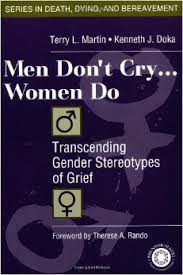Instrumental and Intuitive Grievers
Transcending gender stereotypes of grief.
Early on in my role at my OPO, I listened to a colleague talk about a family he had worked with following the death of their young son. The father and the boy were in a car accident together. The father had some injuries but would survive. Sadly, his son would not so we were there to discuss with him and his wife, the boy’s mother, the opportunity of donation. This family went on to authorize donation and their son was an organ donor. My colleague, in reviewing this case, spent a significant amount of time talking about how “wildly emotional” the father was. The father was crying a lot and was often inconsolable. The child’s mother, on the other hand, was “stoic and cold.” The coordinator never saw her cry and he expressed concern for both of the parents’ emotional states I was new at my job so I didn’t feel as though I had earned the right to question this coordinator’s take on the parents’ grief. I did, however, wonder if the roles were reversed, if the father was the quiet one and the mother was the crying one, would my colleague have mentioned it all? Instead of being “wildly emotional,” the crying mother might have just been a “devastated mother” and the father would not have been “cold and stoic” but “strong and holding it together.” I’ll never know since I didn’t speak up but I wish that I had.
In 1999, Terry Martin and Kenneth Doka published Men Don’t Cry, Women Do: Transcendin g Gender Stereotypes of Grief. Their book emphasized that there are many ways people grieve but that there is a continuum of grief with two different patterns on either end. The Intuitive pattern, often stereotyped as female, is an emotional and affective expression of grief. The Instrumental pattern, often stereotyped as male, is where grief is expressed in a physical or cognitive manner. They assert, and I have seen in my practice, that there are both men who are intuitive grievers and there are women who are instrumental grievers and plenty of men and women in between.
g Gender Stereotypes of Grief. Their book emphasized that there are many ways people grieve but that there is a continuum of grief with two different patterns on either end. The Intuitive pattern, often stereotyped as female, is an emotional and affective expression of grief. The Instrumental pattern, often stereotyped as male, is where grief is expressed in a physical or cognitive manner. They assert, and I have seen in my practice, that there are both men who are intuitive grievers and there are women who are instrumental grievers and plenty of men and women in between.
When we approach families about donation, rarely are we approaching just one person. Even when there is only one legal next of kin, there are often other family members who are part of the conversation. Recognizing that grief can be expressed in a wide variety of ways can make us better at providing the right kind of grief support while discussing donation. Gender may impact the way someone grieves but it is not the determining factor.
The Intuitive Griever
This is the family member who is showing outward signs of their grief. They are openly emotional and that is how they process their grief. Do not try to stunt that emotion or re-direct it. You have to let the emotions flow. So these family members might be the ones with whom you just sit silently with a box of tissues nearby. You listen to them talk about their loved one. You encourage them to tell stories and share meaningful memories about their loved one. This will help them begin to process their loss and can also contribute to creating a trusting relationship with the procurement coordinator. Be wary of our healthcare partners defining these grievers as “over emotional” or “stuck.”
The Instrumental Griever
This family member is the one who is going to ask you a lot of questions. They are going to want to know all the details: When is the recovery going to take place? How will you identify the recipients? What kinds of tests do you need to do? With these grieving family members you patiently answer all their questions. You will probably need to repeat your answers as difficulty with comprehension and concentration are common cognitive grief reactions. They probably are not going to want to engage with you in talking about their loved one but they will eagerly take in all the information you provide to them. They might be the spokesperson for their family members because they are the organizers and the action-oriented folks. They will be the ones to call the funeral home to start making the arrangements. Don’t label or allow these family members to be labeled as “in denial” or “cold.” These grievers use actions to help them process their grief.
Martin and Doka stress that it is important to remember that this is a continuum and rarely is someone exclusively intuitive or instrumental. They believe that most people actually display a more blended grieving style which combines elements of both the intuitive and instrumental grieving styles. Often there is a greater reliance on one style but that is reliant on the person and the situation. So you could also see the outwardly emotional family member also be the one to ask lots of questions. It is rarely an “either-or” situation. You didn’t think it would be that simple, did you?
If I was asked to comment now on the case reviewed by my colleague all those years ago, I would suggest that this father was an intuitive griever and the mother was instrumental griever. I don’t think the gender stereotypes placed on this family by my colleague caused any harm or impacted this family’s donation experience. More so, I hope that this mother and father didn’t inflict these stereotypes on themselves. I hope they didn’t impose any “shoulds” on their grief. I hope they allowed themselves to grieve in a manner that was effective and healthy for them, however that might have looked, and, just as importantly, they allowed their spouse to do the same.
For more information about Instrumental and Intuitive Grief, click here to read an interview with Ken Doka. Also, in 2010, Doka and Martin published an update to their previous book entitled Grieving Beyond Gender: Understanding the Ways Men and Women Mourn, Revised Edition. Additional resources exist at the Hospice Foundation of America (www.hospicefoundation.org) and the Association of Death Education and Counseling (www.adec.org) websites.
Lara Moretti, LSW, CT is the Director of Family Support Services at Gift of Life Donor Program in Philadelphia, PA

